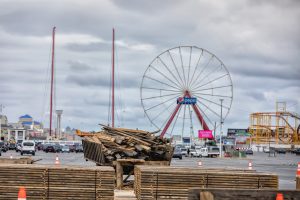
OCEAN CITY – The second phase of a major Boardwalk re-decking project is ongoing and on target for a completion date in April ahead of the summer season.
The complete re-decking of the Boardwalk has been in the works for a number of years and the first phase was completed last spring in advance of the summer season. The second phase began in late October, not long after Sunfest weekend, and the project continues in earnest heading into the new year.
The first phase, which covered the north end from the Boardwalk’s terminus at 27th Street to 15th Street, as well as the south end from the Ocean City Life-Saving Station Museum to the north side of the pier, was completed last spring. The second phase, which includes the section from 15th Street south to the pier, is well underway and on target for an April completion date, according to City Engineer Paul Mauser.
The entire cost of the two-phase Boardwalk re-decking project is around $2.2 million, which is spread over two years in the town’s capital improvement plan. In addition, there is funding made available each year for Boardwalk re-decking from the pier franchise lease agreement.
The wooden sections of the Boardwalk were last replaced entirely in 2010 and 2011 with a life expectancy of 10 years, which put the project right in the window for replacement now. The urgency for the project first surfaced during strategic planning sessions over two years ago and it was identified as a priority in the capital improvement plan, according to Mauser.
“This surface lumber naturally requires frequent cyclical replacement as it is exposed to the beautiful, yet harsh conditions of a coastal environment including constant exposure to UV rays, salt air, coastal storms, temperature fluctuations, and loading from maintenance vehicles, trams, car parades and several million visitors each year,” he said. “These conditions induce inevitable warping, shrinking, splintering and rotting, resulting in a maximum 10-year lifespan of the surface lumber.”
Naturally, during the lifespan of the second phase of the Boardwalk re-decking project, other elements of the historic promenade have been removed or displaced, only to be put back as a section is completed, according to Mauser.
“Taking a closer look at the nuances of the Boardwalk re-decking project, the scope of work requires the temporary removal and staging of all Boardwalk amenities including trash cans, benches and bike racks,” he said. “Couple all of this with an extremely volatile market for lumber and this project is quite a challenge. Town staff was very diligent and kept a close watch of the lumber commodity and was able to bid, and ultimately purchase, the needed lumber close to the low point of the commodity.”
For example, Mauser explained the needed lumber was trading at over $1,300 per thousand board feet last March when the bids were first opened. The town rebid the project and was able to purchase the needed lumber at less than $600 per thousand board feet in late August due to good market timing.
That is no small feat considering the size and scale of the nearly three-mile-long Boardwalk. Although the re-decking project was done in two phases, the amount of lumber needed is considerable. For example, the Boardwalk is comprised of over 80,000 individual pieces of 2-by-6-inch decking boards and more than one million nails fastening the boards to the wood framing structure below. As such, removing and reinstalling 80,000 pieces of lumber is a significant effort.
The winning bid for the second phase included the use of the number-one prime grade of lumber, which Mauser has described as more aesthetically pleasing but not quite as strong as number-one dense. He explained the number-one dense grade is more durable but has supply chain issues and is barely available. He explained going with the number-one dense grade, even if it was readily available, would have brought the project in considerably over what has been budgeted.
There has been talk over the years of replacing the Boardwalk with some other, more durable and long-lasting material, but resort officials have said often there is no substitute for the genuine article. Plastic or concrete options were explored for cost and durability reasons, but in the end, it was determined the public would not sit still for anything other than southern yellow pine from a tradition standpoint, and that is what is being used for the replacement.
Naturally, there have been some detours and other inconveniences during the second phase of the Boardwalk re-decking project. Mauser thanked residents and visitors for their patience during the project.
“Town staff appreciates residents’ and visitors’ patience during this very important project as there may be some detours off the Boardwalk during the weekdays,” he said. “However, the Boardwalk will be fully passable on weekends and holidays. In addition to replacing the Boardwalk surface lumber, the steel sheet piling that supports the concrete seawall will be recoated to protect the sheet piling and prevent the steel from corroding.”

